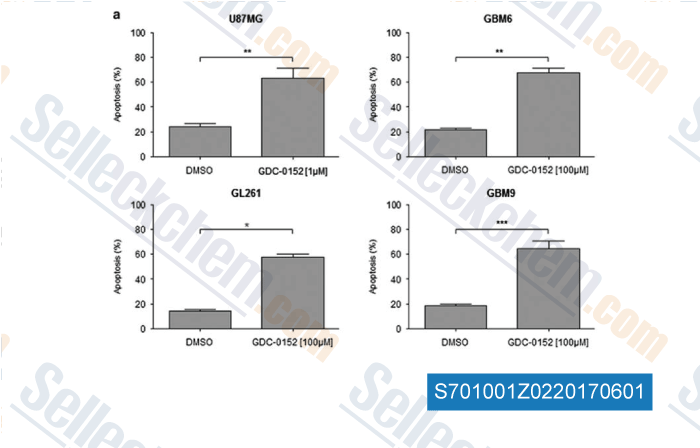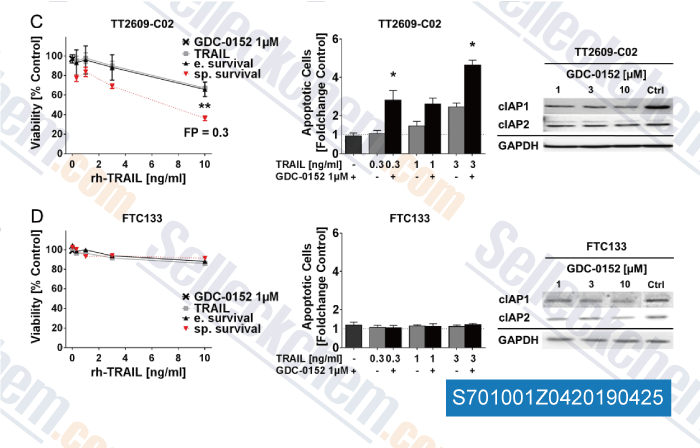|
Toll Free: (877) 796-6397 -- USA and Canada only -- |
Fax: +1-832-582-8590 Orders: +1-832-582-8158 |
Tech Support: +1-832-582-8158 Ext:3 Please provide your Order Number in the email. |
Technical Data
| Formula | C25H34N6O3S |
||||||||||
| Molecular Weight | 498.64 | CAS No. | 873652-48-3 | ||||||||
| Solubility (25°C)* | In vitro | DMSO | 99 mg/mL (198.54 mM) | ||||||||
| Ethanol | 99 mg/mL (198.54 mM) | ||||||||||
| Water | Insoluble | ||||||||||
| In vivo (Add solvents to the product individually and in order) |
|
||||||||||
|
* <1 mg/ml means slightly soluble or insoluble. * Please note that Selleck tests the solubility of all compounds in-house, and the actual solubility may differ slightly from published values. This is normal and is due to slight batch-to-batch variations. * Room temperature shipping (Stability testing shows this product can be shipped without any cooling measures.) |
|||||||||||
Preparing Stock Solutions
Biological Activity
| Description | GDC-0152 is a potent antagonist of XIAP-BIR3, ML-IAP-BIR3, cIAP1-BIR3 and cIAP2-BIR3 with Ki of 28 nM, 14 nM, 17 nM and 43 nM in cell-free assays, respectively; less affinity shown to cIAP1-BIR2 and cIAP2-BIR2. Phase 1. | ||||||||||
|---|---|---|---|---|---|---|---|---|---|---|---|
| Targets |
|
||||||||||
| In vitro | GDC-0152 can block protein−protein interactions that involve IAP proteins and pro-apoptotic molecules. Using transiently transfected HEK293T cells, this compound is shown to disrupt XIAP binding to partially processed caspase-9 and to disrupt the association of ML-IAP, cIAP1, and cIAP2 with Smac. In melanoma SK-MEL28 cells, the endogenous association of ML-IAP and Smac is effectively also abolished by this chemical. It leads to a decrease in cell viability in the MDA-MB-231 breast cancer cell line, while having no effect on normal human mammary epithelial cells (HMEC). This compound is found to activate caspases 3 and 7 in a dose- and time-dependent manner. It is shown to induce rapid degradation of cIAP1 in A2058 melanoma cells. It effectively induces degradation of cIAP1 at concentrations as low as 10 nM, consistent with its affinity for cIAP1. | ||||||||||
| In vivo | GDC-0152 has moderate predicted hepatic clearance based on metabolic stability assays conducted using human liver microsomes. Plasma−protein binding of this compound is moderate and comparable among mice (88−91%), rats (89−91%), dogs (81−90%), monkeys (76−85%), and humans (75−83%) over the range of concentrations investigated (0.1−100 μM); higher plasma−protein binding is observed in rabbits (95−96%). It does not preferentially distribute to red blood cells with blood−plasma partition ratios ranging from 0.6 to 1.1 in all species tested. The pharmacokinetics for this chemical is achieved with a C max of 53.7 μM and AUC of 203.5 h•μM. [1] |
Protocol (from reference)
| Kinase Assay:[1] |
|
|---|---|
| Cell Assay:[1] |
|
| Animal Study:[1] |
|
References
|
Customer Product Validation

-
, , PLoS One, 2015, 10(5):e0128647.

-
Data from [ , , Cell Death Dis, 2016, 7(8):e2325 ]

-
Data from [ , , Endocr Relat Cancer, 2018, 25(3):295-308 ]
Selleck's GDC-0152 Has Been Cited by 23 Publications
| Tailoring glioblastoma treatment based on longitudinal analysis of post-surgical tumor microenvironment [ J Exp Clin Cancer Res, 2024, 43(1):311] | PubMed: 39605004 |
| Single-molecule fingerprinting of protein-drug interaction using a funneled biological nanopore [ Nat Commun, 2023, 14(1):1461] | PubMed: 37015934 |
| Protein folding stress potentiates NLRP1 and CARD8 inflammasome activation [ Cell Rep, 2023, 42(1):111965] | PubMed: 36649711 |
| In vitro analysis reveals necroptotic signaling does not provoke DNA damage or HPRT mutations [ Cell Death Dis, 2020, 11(8):680] | PubMed: 32826875 |
| Smac Mimetics Can Provoke Lytic Cell Death That Is Neither Apoptotic Nor Necroptotic [ Apoptosis, 2020, 21] | PubMed: 32440848 |
| EBV(LMP1)-induced metabolic reprogramming inhibits necroptosis through the hypermethylation of the RIP3 promoter. [ Theranostics, 2019, 9(9):2424-2438] | PubMed: 31131045 |
| HTiP: High-Throughput Immunomodulator Phenotypic Screening Platform to Reveal IAP Antagonists as Anti-cancer Immune Enhancers [ Cell Chem Biol, 2019, 26(3):331-339] | PubMed: 30639259 |
| WX20120108, a novel IAP antagonist, induces tumor cell autophagy via activating ROS-FOXO pathway. [ Acta Pharmacol Sin, 2019, 10.1038/s41401-019-0253-5] | PubMed: 31316176 |
| Enteroendocrine Progenitor Cell-Enriched miR-7 Regulates Intestinal Epithelial Proliferation in an Xiap-Dependent Manner. [ Cell Mol Gastroenterol Hepatol, 2019, 10.1016/j] | PubMed: 31756561 |
| Inhibitor of Apoptosis Proteins Determines Glioblastoma Stem-Like Cell Fate in an Oxygen-Dependent Manner [ Stem Cells, 2019, 37(6):731-742] | PubMed: 30920104 |
RETURN POLICY
Selleck Chemical’s Unconditional Return Policy ensures a smooth online shopping experience for our customers. If you are in any way unsatisfied with your purchase, you may return any item(s) within 7 days of receiving it. In the event of product quality issues, either protocol related or product related problems, you may return any item(s) within 365 days from the original purchase date. Please follow the instructions below when returning products.
SHIPPING AND STORAGE
Selleck products are transported at room temperature. If you receive the product at room temperature, please rest assured, the Selleck Quality Inspection Department has conducted experiments to verify that the normal temperature placement of one month will not affect the biological activity of powder products. After collecting, please store the product according to the requirements described in the datasheet. Most Selleck products are stable under the recommended conditions.
NOT FOR HUMAN, VETERINARY DIAGNOSTIC OR THERAPEUTIC USE.
